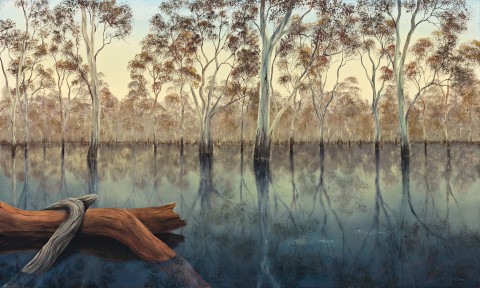DEEP WATER (MATONG), 1995
LIN ONUS
synthetic polymer paint on linen
91.0 x 152.0 cm
signed lower right: LIN ONUS
bears inscription verso: cat. 039 S011 and cat. 9512
bears inscription on label verso: artist’s name, date, title and medium
bears inscription on stretcher bar verso: ‘MATONG’
Estate of the Artist, Melbourne
Private collection, Melbourne
Deutscher and Hackett, Sydney, 20 September 2017, lot 20
Private collection, Sydney
Bama-Mutjing (Barmah – My Father’s Country), Gallery Gabrielle Pizzi, Melbourne, 12 September – 8 October 1995, cat. 18 (label attached verso)
Barmah Forest, 1994, synthetic polymer paint on linen, 183.0 x 244.0 cm, in the collection of the Australian Heritage Commission, Canberra, illus. in Neale, M., Urban Dingo: The Art and Life of Lin Onus 1948 – 1996, Craftsman House, Sydney, 2000, p. 76
Morumbeeja Pitoa (Floods and Moonlight), 1993, oil on canvas, 182.0 x 182.0 cm, in the collection of Queensland Art Gallery, Brisbane, illus. in Neale, M., Urban Dingo: The Art and Life of Lin Onus 1948 – 1996, Craftsman House, Sydney, 2000, p. 104
Lin Onus’ depiction of land has been interpreted by art historian Sylvia Kleinert as not only a ‘means of retrieving and rewriting history’, but also vitally important because he responded to the land as a ‘cultural archive’.1 When Onus was asked what school or movement of art he belonged to, he often replied, ’the Bower Bird School. You know the one – picking up bits and pieces, here and there.’2 The son of a Scottish mother and a Yorta Yorta man from the Aboriginal mission of Cummerangunja near Echuca, Onus described himself as a self-confessed cultural mechanic,3 someone whose art interlaced elements from his European and Aboriginal heritages bringing together the two parts; one Western and representational and the other Aboriginal and spiritual.
The Barmah Forest on the Victorian side of the Murray River is Onus’ ancestral and spiritual home. His father’s county and a place Onus would regularly return to, where he would sit along the banks of the Murray River looking out over the Barmah Forest and its great trees reflected in the mirrored waters. There his uncle Aaron Briggs, also known as ‘the old man of the forest’, would tell Onus about his Koori heritage and the stories of the river.4 It is this spiritual narrative that ebbs and flows through this important body of works, which culminated in the critical example, Barmah Forest, 1994 now in the collection of the Australian Heritage Commission, Canberra and reflects a theme that Onus returned to often in the final period of his life. Deep Water (Matong), 1995, shows the forest during flood, a regular occurrence during high flows of the Murray River and a time of rejuvenation for the Barmah wetlands. Onus captures this sanctuary-like quality of the forest wetlands in his depiction of the still, reflective surface of the waters but it is his inclusion of cross hatched fish viewed through the water that illustrate his idea of (cultural) transparency and the existence of tradition and meaning beneath the surface of everything.
This stylistic evolution was the result of the relationship he fostered in Arnhem Land with the highly esteemed Aboriginal painter Jack Wunuwun, who became his adoptive father and mentor. Margo Neale notes that from 1986 – 1996, Onus made 16 ‘spiritual pilgrimages’ to Garmedi,5 resulting in a brilliant personal style that juxtaposed the rarrk clan patterns of Maningrida, learnt from the older artist, with a photorealist style of landscape. This combination created a visual disjuncture, rich in reflections and ambiguities, that acts as a metaphor for the cultural destruction suffered as a result of colonisation, substituting the traditional European panoramic view for one described by his mentor Wunuwun as ‘seeing below the surface’.
It has been over two decades since Lin Onus died tragically and prematurely in Melbourne in October 1996. Onus died before the recognition of his art and activism, both of which clearly exposed the inequality facing indigenous Australians, was honored at a retrospective of his work held at the Queensland Art Gallery in 2000 and touring nationally in 2001.
1. Kleinert, S., ‘Aboriginal Enterprises: negotiating an urban Aboriginality’, Aboriginal History, vol. 34, 2010 accessed online August 2017
http://press-files.anu.edu.au/downloads/press/p170581/html/ch07.xhtml?re...
2. Neale, M., Urban Dingo - the Art and Life of Lin Onus 1948-1996, Queensland Art Gallery, Brisbane, 2000, p. 12
3. Onus, L., artist statement, 1990
4. Neale, M., op. cit., pp. 13 – 14
5. ibid., p. 15
CRISPIN GUTTERIDGE
